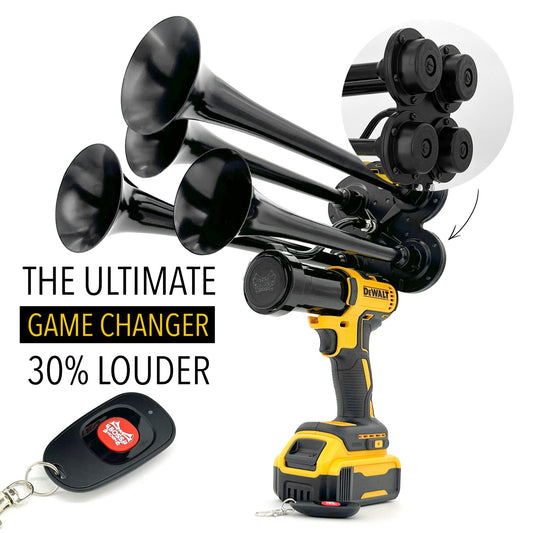When you hear a car horn blaring, it can certainly grab your attention. Similar to a sonic alarm clock, a car horn is intended to alert others and ensure safety on the road. Since its invention, the sound produced by a car horn has evolved from simple mechanical devices to electronically-powered units. However, have you ever wondered just how loud a car horn can be?
The concept of measuring sound intensity is where we find the answer. Decibels (dB) are used to quantify the level of sound produced by various sources, including car horns. Decibels, a logarithmic unit, express the relative amplitude of sound waves. The higher the decibel level, the more intense the sound. For reference, a normal conversation usually registers around 60 dB, while a rock concert can reach an astonishing 120 dB.
Now, let's delve into the history of car horns. The first car horns were introduced in the late 1800s, functioning as simple brass instruments operated by levers or buttons. They emitted a relatively low sound intensity compared to today's car horns. Over time, car manufacturers realized the need for louder horns to grab the attention of distracted drivers or pedestrians. Modern car horns, powered by electricity, can produce sound levels ranging from 100 to 150 dB, depending on the specific model and manufacturer.
The importance of having a loud car horn became evident due to the increasing number of vehicles on the road. According to recent statistics, there are over one billion cars worldwide. With such a dense concentration of automobiles, communication through horn signals has become crucial in preventing accidents and making our roads safer. In fact, studies have shown that the use of car horns can reduce the likelihood of collisions by creating awareness and alertness among drivers.
Given the significance of car horns for road safety, it's essential to ensure that they deliver the intended message. That is why regulations and standards have been established to limit the maximum sound intensity produced by car horns. These regulations vary by country but generally aim to strike a balance between loudness and potential noise pollution. Compliance with these standards ensures that car horns are effective tools for communication without causing unnecessary disturbance to the surrounding environment.
In conclusion, car horns are designed to draw attention and facilitate communication on the road. The decibel level at which a car horn operates plays a crucial role in achieving this objective. By understanding the history, significance, and regulations surrounding car horns, we can appreciate their importance in promoting road safety. So, next time you hear a car horn blaring, remember that it's more than just a noise – it's a tool for keeping us all safe on the streets.
How loud is a car horn? Exploring the decibel levels and impact of car horns.
When it comes to car horns, understanding their decibel levels is essential for safety and communication on the roads. Decibels are a unit to measure sound intensity, and in the case of car horns, they determine just how loud these devices can be. Car horns are designed to emit a loud noise that alerts others on the road to potential danger or signals an important message. In this article, we will delve into the decibel levels of car horns, exploring how they are measured and the impact they have on various situations. We will also discuss the importance of car horn regulations and how excessive noise can lead to legal consequences. So, let's dive deeper into the fascinating world of car horn decibels and their role in road safety.
Types of Car Horns
Car horns come in various types, each producing different levels of sound. The two most common types of car horns are the electric horn and the air horn.
Electric Horn:
An electric horn is the traditional type of horn found in most cars. It operates using an electromagnet that causes a metal diaphragm to vibrate, producing sound waves. The sound level of an electric horn typically ranges from 97 to 110 decibels (dB) at a distance of 2 meters. However, some electric horns can reach higher levels, up to 120 dB. These horns are designed to be loud enough for drivers to alert others of their presence on the road.
Air Horn:
Air horns, also known as truck horns, produce an even louder sound compared to electric horns. They are commonly found in larger vehicles like trucks and buses. Air horns work by releasing compressed air through a trumpet-like device, creating a powerful and attention-grabbing noise. The sound level of an air horn can range from 120 to 150 dB, depending on the specific model and manufacturer. It is important to note that prolonged exposure to sound levels exceeding 85 dB can cause hearing damage, so caution should be exercised when using air horns.
Regulations and Safety Considerations
Car horns are regulated by local traffic laws to ensure that they are used responsibly and do not cause unnecessary noise pollution. In many countries, including the United States, car horns are required to emit a sound level ranging from 88 to 100 dB at a distance of 2 meters.
Noise Pollution and Disturbance:
Excessive and unnecessary honking can contribute to noise pollution, disturb the peace, and potentially harm people's hearing. Therefore, it is crucial for drivers to use car horns only when necessary, such as to warn pedestrians or other vehicles of an imminent danger or to prevent accidents.
Alternative Warning Devices:
In some situations where using a car horn might not be appropriate or allowed, alternative warning devices can be used. These include flashing lights, hand signals, or the use of hazard indicators to communicate with other road users.
Statistics on Car Horn Usage
- According to a study conducted by the Journal of Safety Science, the average car horn is used approximately 640 times per year per vehicle.
- In congested cities, it is estimated that drivers use their car horns as much as 18 times per hour.
- A survey conducted in the United Kingdom found that 71% of drivers admitted to using their car horns out of frustration with other road users.
- In a separate study, researchers found that prolonged exposure to car horn noise can lead to increased stress levels and even trigger cardiovascular problems.
https://youtube.com/watch?v=GgQLiyZ5U0Q
Frequently Asked Questions about the Decibel Level of Car Horns:
1. What is the average decibel level of a car horn?
Car horns vary in their decibel levels, but on average, they produce a significant amount of sound. The volume of a car horn is designed to be loud enough to alert others on the road, ensuring safety and effective communication while driving.
Three important pieces of information:
- Car horns produce a substantial amount of sound.
- The decibel level of a car horn varies.
- The loudness of a car horn is designed for effective communication and safety.
2. Are car horns louder than everyday sounds?
Yes, car horns are typically louder than everyday sounds we encounter. While the decibel level of car horns varies, they are designed to stand out amidst the background noise of traffic and urban environments. This ensures that the sound reaches a wider range of people and effectively grabs attention in potentially hazardous situations.
Three important pieces of information:
- Car horns are generally louder than everyday sounds.
- They are designed to stand out in busy traffic and urban environments.
- The purpose of car horns is to grab attention and prevent accidents.
3. How do car horns compare to other common noise sources?
Car horns generally produce a louder sound compared to many other common noise sources. While car horns are designed to be attention-grabbing, they are carefully regulated to prevent excessive noise pollution. This is to maintain a balance between safety and ensuring a peaceful environment for everyone.
Three important pieces of information:
- Car horns produce louder sounds than most other common noise sources.
- Regulations are in place to prevent excessive noise pollution from car horns.
- Balancing safety and noise pollution is crucial when it comes to car horns.
4. Can car horns cause hearing damage?
Yes, prolonged exposure to loud car horns can potentially cause hearing damage. This is why it is important to use car horns responsibly and sparingly. The human ear is sensitive, and exposure to excessively loud sounds can lead to various hearing problems such as tinnitus or permanent hearing loss.
Three important pieces of information:
- Prolonged exposure to loud car horns can lead to hearing damage.
- Responsible and sparing use of car horns is recommended.
- Hearing problems like tinnitus or hearing loss can result from excessive horn use.
5. Are there regulations regarding the decibel level of car horns?
Yes, regulations are in place to ensure that car horns do not exceed certain decibel levels. These regulations vary across different jurisdictions, but they generally aim to strike a balance between road safety and noise pollution. It is important for vehicle owners to comply with these regulations and use car horns in a responsible manner.
Three important pieces of information:
- Regulations exist to limit the decibel levels of car horns.
- These regulations vary across different jurisdictions.
- Complying with car horn regulations is essential for responsible usage.
Overall, car horns are designed to be attention-grabbing and ensure safety on the road. While their decibel levels vary, car horns generally produce loud sounds that surpass everyday noises. It is important to use car horns responsibly, as prolonged exposure can potentially cause hearing damage. Regulations are in place to maintain a balance between safety and noise pollution, making it essential for vehicle owners to comply with these regulations.
Conclusion
In conclusion, the decibel level of a car horn can vary depending on the specific car model and type of horn installed. On average, car horns produce sound levels ranging from 100 to 110 decibels. However, some truck and train horns can reach up to 150 decibels, which is significantly louder. It is important to note that prolonged exposure to loud car horns can have adverse effects on hearing, and therefore, caution should be exercised in their use.














